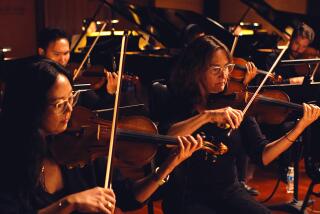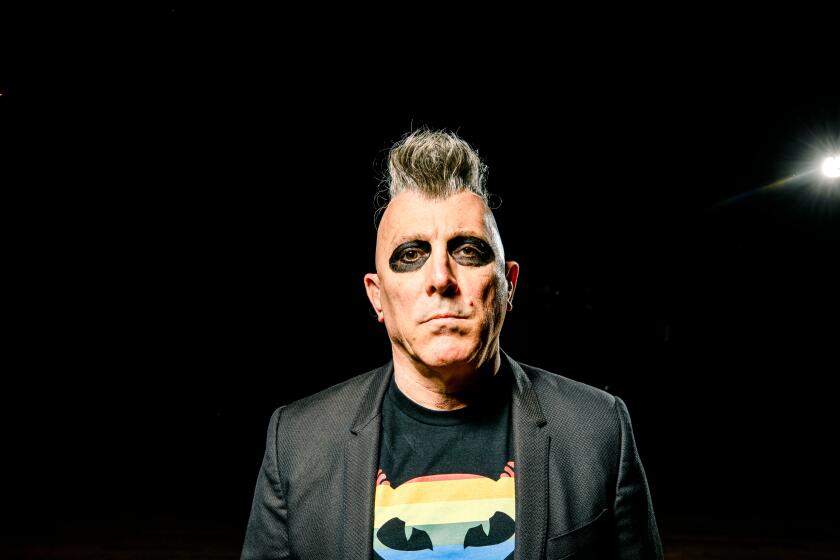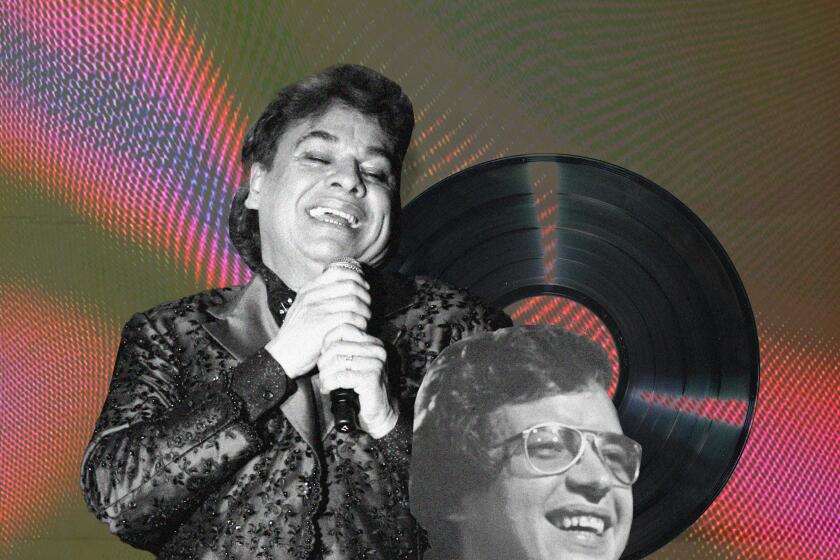Mark O’Connor, genre fiddler

Mark O’Connor sat in the small theater at UCLA as three earnest young music students -- a violinist, a cellist and a pianist -- determinedly worked through one movement of his Piano Trio No. 1, a piece commissioned and recorded by the Eroica Trio, one of chamber music’s stellar ensembles. Once they finished, O’Connor walked onstage, complimented their performance and picked up his violin to demonstrate a few pointers on tempo, technique and playing style.
FOR THE RECORD:
Mark O’Connor: An article in Sunday’s Arts & Music section about violinist-composer Mark O’Connor described one of his mentors as “Gypsy jazz violinist Stephane Grappelli.” Grappelli was a French violinist who partnered with Gypsy guitarist Django Reinhardt to help create what became known as Gypsy jazz. —
“At letter G,” the violinist-composer said, as his charges quickly flipped pages to find that spot in the score, “this section emulates the Johnny Cash guitar strum where he goes up the neck.” He mimicked the Man in Black’s signature chick-chicka-chick strumming style and then mentioned how Cash’s late-career performance of the Nine Inch Nails song “Hurt” had introduced the veteran artist to a new generation of fans shortly before his death in 2003.
“Go to YouTube,” he suggested, “and watch the video of him singing it. It’s a very effective performance. Hearing and seeing him play that song will help you play this part.”
Over the last two decades, O’Connor has built an imposing repertoire of his own compositions, including his piano trio “Poets and Prophets,” inspired by Cash’s life and music. Among other pieces of music, he’s written six concertos, three string quartets, six caprices and other works for solo violin (among them his signature “Appalachia Waltz”). The world premiere recording of what might be his most ambitious work yet, the six-movement “Americana Symphony” as played by the Baltimore Symphony under conductor Marin Alsop, will be released Tuesday on O’Connor’s own Omac record label.
For the last two decades, the 47-year-old artist, who studied as a teen with Texas fiddle champion Benny Thomasson and then apprenticed under fabled Gypsy jazz violinist Stephane Grappelli, has concentrated on writing and performing music that bridges disparate genres. His aim? To blend classical with American folk and popular music more fully than he believes occurred even in the celebrated works of Aaron Copland, George Gershwin, Duke Ellington and Leonard Bernstein.
“I think there’s a real possibility that a nationalistic American classical music could really start to take hold,” O’Connor said during a recent interview at a coffeehouse near UCLA’s Herb Alpert School of Music, the new cross-disciplinary institution that tapped him this year as its first artist-in-residence.
“This school is founded on the idea that there is a universe of music, and within that universe there are different galaxies of classical music, world music, jazz and folk,” said Alpert director Tim Rice. “We’re sending out these shuttles that move from one galaxy to the other. Mark is the very embodiment of that idea.”
O’Connor’s “Americana Symphony,” subtitled “Variations on Appalachia Waltz,” is as unrepentantly tonal, accessibly melodic and sonically spacious as a great Elmer Bernstein film score. As in most of his work, themes develop, mutate and transform with complex passage work that often incorporates bent notes or pulsing rhythms drawn from jazz, country, folk and blues sources.
“I want to use jazz and blues and other vernacular music as the language on which classical compositions are built,” O’Connor said. “It’s the same thing [Astor] Piazzolla did in his native Argentina, what Bartók did in Hungary and what Tan Dun is doing in China. It’s not a new concept. It’s just new in American classical circles. It’s so funny -- it reveals some people’s idea that our cultural musical heritage is somehow not important enough.”
O’Connor’s passion for history, including this country’s cultural past and his own family’s journey, surfaces regularly in conversation. His mother’s ancestors came from Holland to New York in the early 17th century -- “before Jamestown,” he said -- migrated south in the 19th century and then settled in the Pacific Northwest. He essentially has followed that path in reverse, now residing in Manhattan.
As a boy in Seattle, O’Connor studied classical guitar, at the same time being captivated by the sounds of country music. After seeing Doug Kershaw play Cajun-style fiddle on Cash’s late-’60s TV show, he asked his parents to buy him one. He considers himself blessed to have connected with Thomasson, who had relocated to Seattle in the ‘70s after dominating fiddling competitions in the Lone Star State for nearly two decades.
O’Connor began making records as a teen and moved to Nashville not long after graduating from high school. That was during the “Urban Cowboy” pop-crossover craze of the early-’80s, a time when a Nashville music executive famously circulated a memo stipulating “no steel guitars” on any of the label’s recordings. It was the same story for the old-time fiddle.
“Buddy Spicher, one of the great session players of the ‘60s and ‘70s, told me, ‘Kid, you came to town at the wrong time -- all the work has dried up.’ But I had an idea that I could prove that a fiddle could play alongside a DX7 [synthesizer], a rock guitar or a Fender Rhodes [electric piano]. I’ve been cross-pollinating for my entire career.”
The following decades were a lucrative time for O’Connor. He easily could have stayed in Nashville playing work-for-hire sessions as one of Music City’s most in-demand players -- the Country Music Assn. named him its musician of the year for six years running, 1991 to ’96. But he opted for larger creative pursuits.
“I wrote the first caprice 22 years ago, between recording sessions. I’d had the beginnings of a new fiddle concerto and decided it was time to quit the session work and go on a solo career based on this principle of combining jazz and folk and classical music. A lot of people thought I was nuts for putting a career behind me in favor of one that could maybe pay half my rent. But other things I might have done weren’t terribly meaningful.”
A natural development
During the UCLA master class, where different groups of students played sections from three of his works, O’Connor could see evidence of the evolution of music education that he’s been pushing for. “I was impressed at how students were able to access what I wanted off the page,” he said. “When Yo-Yo Ma first expressed interest in my music, he said, ‘I can’t see your music in the notes, I have to hear you playing it.’ And I thought, ‘Boy, this is going to be a problem if this won’t exist outside of me playing it.’ ”
But that’s changing, with so many other things, in the iPod age -- in that fans can explore different styles of music more readily than ever now, making them less likely to limit themselves to any single genre. O’Connor himself spreads the gospel of a borderless music world in the summer camps for string players he’s led in Nashville for 15 years and, starting in July, in Los Angeles and New York City. The local camp at UCLA replaces the ones he used to offer farther south when he lived in San Diego.
He’s moving his mission another step ahead with the publication this month of the Mark O’Connor Violin Method, an approach to learning to play the instrument rooted in American music, as opposed to the European and Japanese methods that currently dominate violin instruction. His answer to the Suzuki method’s use of Mozart’s “Twinkle, Twinkle Little Star” for foundational music training is “Boil Them Cabbage Down,” an old folk tune that Thomas Jefferson once played.
“What Mark and a few other people are doing is hearkening back to an older definition of what it means to be a well-rounded musician,” said David Wallace, a violist and colleague of O’Connor’s who is on the faculty at the Juilliard School in New York.
“Music pedagogy in the 20th century became a science, and became very specialized,” said Wallace, a member of the teaching artist faculty for the New York Philharmonic. “To be a musician in Bach and Haydn and Mozart’s day meant you were fluent in multiple instruments, fluent in multiple national styles. They were also able to improvise, ornament and embellish and they were trained in composition and theory. In a way, what’s starting to happen now is that all these elements are being brought back.”
To O’Connor, that constitutes the flowering of seeds he’s planted over the last two decades as a composer and tireless proponent of the American melting pot ideal as it applies to music.
“The biggest part of the last decade as far as my career was about my performances, my playing, my music,” he said. “Now in my life it’s more about what this music means to other musicians. It’s becoming less about my performances as an artist and maybe more about being in a leadership position to steer in new ideas and bring new material for people to try out. It’s a really, really gratifying development.”
More to Read
The biggest entertainment stories
Get our big stories about Hollywood, film, television, music, arts, culture and more right in your inbox as soon as they publish.
You may occasionally receive promotional content from the Los Angeles Times.






